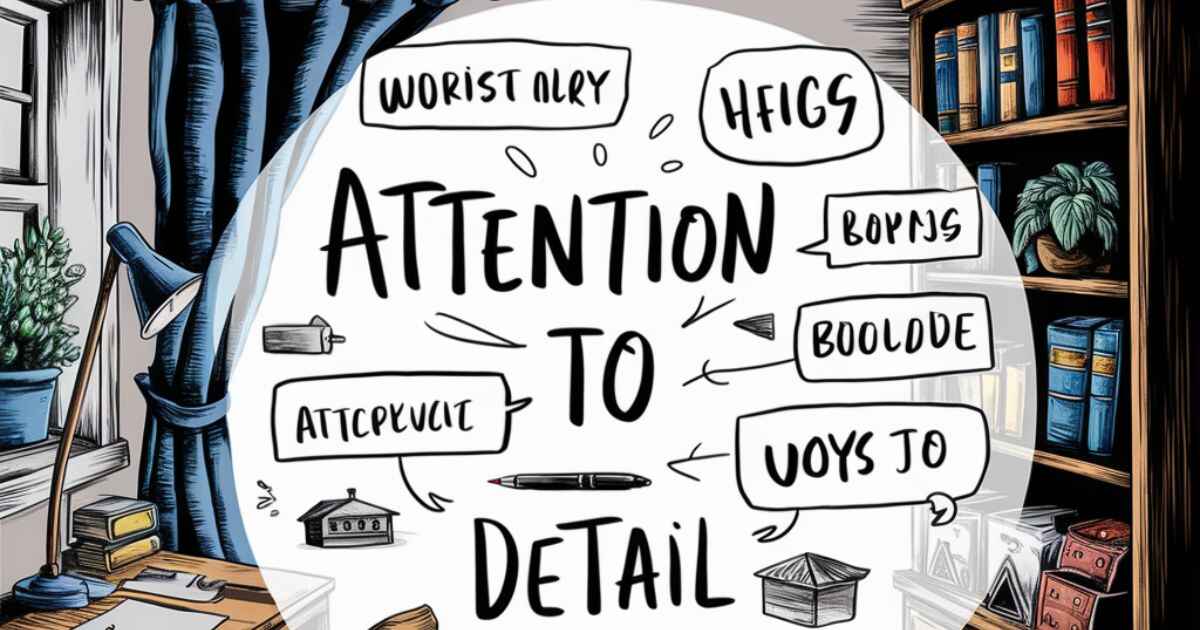Ever been called a perfectionist? Well, guess what? That might just be your superpower! In a world where the devil’s in the details, having a keen eye for the little things can set you apart from the crowd. But let’s face it, saying “attention to detail” over and over can get a bit stale. That’s why we’re diving into 15 fresh ways to express this crucial skill. Whether you’re sprucing up your resume or just want to impress your boss, these alternatives will have you covered. So, let’s get down to the nitty-gritty and explore the art of precision! 15 Ways To Say “Attention to Detail”.
Alternative Ways To Say “Attention to Detail”

Why do we need different ways to say “attention to detail”? Well, variety is the spice of life, isn’t it? Plus, in the competitive job market or even in everyday conversations, having a diverse vocabulary can make you stand out. It’s not just about sounding smart; it’s about expressing yourself accurately and impressively.
Here’s a quick rundown of our 15 alternatives:
- Accuracy
- Consistency
- Meticulousness
- Precision
- Rigor
- Punctuality
- Thoroughness
- Exactness
- Detail-oriented
- Particularity
- Scrutiny
- Strictness
- Attentiveness
- Conscientiousness
- Carefulness
Each of these words brings its flavor to the table. They’re not just synonyms; they’re nuanced expressions that can help you communicate your strengths more effectively. Let’s break them down, shall we?
Accuracy: Hitting the Bullseye Every Time
Accuracy is all about getting things right on the money. It’s the difference between landing on the moon and floating endlessly in space. In fields like accounting, medicine, and engineering, accuracy isn’t just important – it’s critical.
Take the Mars Climate Orbiter, for example. In 1999, NASA lost this $125 million spacecraft because of a simple unit conversion error. One team used metric units, while another used imperial. The result? The orbiter got too close to Mars and disintegrated in its atmosphere. Talk about an expensive mistake!
To improve your accuracy:
- Double-check your work (and then check it again)
- Use tools and technology to verify calculations
- Develop a systematic approach to tasks
- Take breaks to maintain focus
Remember, accuracy is a skill you can hone. It’s not about being perfect all the time; it’s about consistently striving for correctness. 15 Ways To Say “Attention to Detail”.
Consistency: The Hallmark of Reliability
Consistency in attention to detail is like the rhythm in music – it keeps everything in harmony. It’s what makes McDonald’s fries taste the same whether you’re in New York or New Delhi. In the business world, consistency builds trust and reliability.
Consider the case of Coca-Cola. Their secret formula has remained largely unchanged since 1886. This consistency in taste, combined with consistent branding and quality control, has made Coca-Cola one of the most recognized brands worldwide. 15 Ways To Say “Attention to Detail”.
To maintain consistency in your work:
- Create and follow standard operating procedures
- Use checklists for repetitive tasks
- Regularly review and update your processes
- Seek feedback to ensure your output is consistently high-quality
Remember, consistency doesn’t mean resistance to change. It means providing a reliable, high-quality output that people can count on.
Meticulousness: Leaving No Stone Unturned
Being meticulous means paying attention to even the tiniest details. It’s the watchmaker carefully assembling hundreds of tiny components, or the detective combing through evidence to crack a case.
Leonardo da Vinci was famous for his meticulous nature. His notebooks are filled with detailed observations and sketches of everything from human anatomy to water flow patterns. This meticulous approach led to groundbreaking insights in art, science, and engineering.
To cultivate meticulousness:
- Break large tasks into smaller, manageable parts
- Use magnification tools when necessary (literally or figuratively)
- Allocate enough time for thorough work
- Develop a genuine interest in the details of your field
But remember, there’s a fine line between being meticulous and being obsessive. The goal is to be thorough, not to get lost in the details.
Precision: The Fine Art of Exactness
Precision is often confused with accuracy, but they’re not quite the same. Accuracy is about being correct, while precision is about being exact. Think of it this way: if you’re aiming at a target, accuracy gets you to hit the bullseye, but precision ensures you can hit that same spot repeatedly.
In fields like surgery or watchmaking, precision is paramount. A surgeon’s cut that’s off by a millimeter can have serious consequences. Similarly, a tiny imprecision in a watch mechanism can throw off its timekeeping significantly.
To improve precision in your work:
| Technique | Description | Example |
|---|---|---|
| Use the right tools | Ensure you have tools that allow for precise work | Using a micrometer instead of a ruler for small measurements |
| Practice regularly | Repetition helps refine your precision | Practicing penmanship to improve handwriting precision |
| Focus on one task at a time | Multitasking can reduce precision | Concentrating solely on coding without checking emails |
| Create a distraction-free environment | Minimize interruptions to maintain focus | Using noise-cancelling headphones in a busy office |
Remember, precision is a skill that can be developed over time with practice and the right approach.
Rigor: Embracing Thorough and Exact Methods
Rigor is all about being thorough and precise in your approach. It’s the scientist meticulously documenting every step of an experiment, or the lawyer carefully examining every clause in a contract.
In academia, rigor is the backbone of credible research. The scientific method itself is a testament to rigor – carefully forming hypotheses, designing experiments, and analyzing results.
To apply rigor to your everyday problem-solving:
- Define the problem clearly
- Gather all relevant information
- Consider multiple solutions
- Test your solutions systematically
- Document your process and results
By embracing rigor, you’re not just solving problems – you’re building a reliable, repeatable process for excellence.
Punctuality: The Timeliness of Perfection
Punctuality might seem out of place in a discussion about attention to detail, but it’s actually a crucial component. Being on time shows respect for details like schedules and commitments.
In some cultures, punctuality is highly prized. In Germany, for instance, being late to a business meeting can be seen as a serious faux pas. On the other hand, in some Latin American countries, arriving a bit late to a social gathering is often expected.
To improve your punctuality:
- Overestimate travel time
- Set multiple alarms
- Prepare things in advance
- Use digital calendars with reminders
Remember, punctuality isn’t just about being on time – it’s about respecting the details of your commitments.
Thoroughness: Covering All Bases
Thoroughness is about leaving no stone unturned, no angle unconsidered. It’s the editor who reads a manuscript multiple times, each time focusing on different aspects like grammar, plot consistency, and character development.
In fields like quality assurance or auditing, thoroughness is essential. A thorough QA tester might save a company millions by catching a critical bug before a product launch.
Here’s a quick checklist for ensuring thoroughness in your projects:
- [ ] Define clear objectives
- [ ] Break the task into smaller components
- [ ] Create a timeline for each component
- [ ] Use checklists for repetitive tasks
- [ ] Review your work from different perspectives
- [ ] Seek feedback from others
- [ ] Double-check your results
By being thorough, you’re not just completing tasks – you’re delivering comprehensive, high-quality work.
Exactness: The Pursuit of Perfection
Exactness is about getting things precisely right. It’s the mathematician proving a theorem, leaving no room for ambiguity, or the pharmacist measuring medication to the milligram.
In fields like law or computer programming, exactness is crucial. A single misplaced word in a contract or a tiny error in a line of code can have far-reaching consequences.
To balance exactness with efficiency:
- Understand the required level of precision for each task
- Use tools and technology to aid in exactness
- Develop a system for checking your work
- Know when “good enough” is sufficient
Remember, while exactness is important, perfection can sometimes be the enemy of progress. The key is to know when exactness is critical and when it’s okay to be a bit more flexible. 15 Ways To Say “Attention to Detail”.
Detail-Oriented: The Classic Description
“Detail-oriented” remains a powerful phrase because it encapsulates so much. It suggests someone who notices and cares about the little things that others might overlook.
To demonstrate your detail-oriented nature in interviews:
- Provide specific examples of when your attention to detail made a difference
- Discuss your methods for organizing and tracking details
- Highlight any relevant tools or software you use to manage details
- Share how you balance focusing on details with seeing the big picture
To sharpen your detail-oriented skills, try these exercises:
- Spot the different puzzles
- Proofreading texts
- Organizing complex data sets
- Recreating detailed images from memory
Being detail-oriented isn’t about obsessing over every little thing – it’s about knowing which details matter and giving them the attention they deserve. 15 Ways To Say “Attention to Detail”.
Particularity: The Fine-Tuning of Focus
Being particular means having specific preferences or requirements. In the context of attention to detail, it’s about focusing on the exact aspects that matter most.
Steve Jobs was famously particular about design. He obsessed over details like the radius of corners on Apple devices or the exact shade of white for Apple stores. This particularity led to products that weren’t just functional, but beautiful and user-friendly.
To enhance quality through particularity:
- Identify the most crucial aspects of your work
- Develop clear standards for these aspects
- Regularly review and refine these standards
- Communicate your standards clearly to others
But be careful – being overly particular can lead to perfectionism and inefficiency. The goal is to be particular about the things that truly matter.
Scrutiny: The Power of Close Examination

Scrutiny involves examining something closely and critically. It’s the art of looking beyond the surface to uncover hidden truths or potential issues. 15 Ways To Say “Attention to Detail”,
Sherlock Holmes is the quintessential example of scrutiny in action. His ability to notice and interpret tiny details led to solving complex cases. In the real world, scrutiny has led to major scientific breakthroughs, like the discovery of penicillin when Alexander Fleming noticed something unusual in a contaminated petri dish.
To develop a keen eye for detail:
- Practice mindful observation
- Ask probing questions
- Look for patterns and anomalies
- Consider multiple perspectives
- Use tools like magnifiers or analytical software when necessary
Remember, scrutiny isn’t about being critical for the sake of it. It’s about examining things closely to gain a deeper understanding or uncover potential improvements. 15 Ways To Say “Attention to Detail”.
Strictness: Adhering to High Standards
Strictness in attention to detail means consistently adhering to high standards. It’s about setting a high bar and refusing to let it drop.
In manufacturing, strictness in quality control can be the difference between a successful product and a costly recall. Companies like Toyota have built their reputation on strict adherence to quality standards.
To balance strictness with flexibility:
- Clearly define your non-negotiable standards
- Communicate these standards effectively to your team
- Be open to feedback and suggestions for improvement
- Allow for creativity within the bounds of your standards
- Regularly review and update your standards as needed
Remember, being strict doesn’t mean being inflexible. It means knowing what’s important and consistently delivering on those key aspects. 15 Ways To Say “Attention to Detail”.
Attentiveness: The Art of Staying Focused
Attentiveness is about giving your full focus to the task at hand. In our age of constant distractions, the ability to stay attentive is becoming increasingly valuable.
Studies have shown that it takes an average of 23 minutes to fully refocus after an interruption. That’s a lot of lost productivity! By improving your attentiveness, you can enhance your attention to detail and overall efficiency.
Strategies for improving focus:
- Practice mindfulness meditation
- Use the Pomodoro Technique (25 minutes of focused work followed by a 5-minute break)
- Create a distraction-free work environment
- Take regular breaks to recharge your mental energy
- Get enough sleep and exercise to support cognitive function
Remember, attentiveness is like a muscle – the more you practice, the stronger it gets.
Conscientiousness: Taking Care in Every Action
Conscientiousness is about doing things thoroughly and with care. It’s one of the “Big Five” personality traits and has been linked to career success and job satisfaction.
A conscientious person doesn’t just complete tasks – they complete them well, with thought and care put into every aspect. This trait is valuable in virtually every field, from healthcare to customer service. 15 Ways To Say “Attention to Detail”.
To develop a conscientious approach:
- Set clear goals and priorities
- Create and follow through with plans
- Pay attention to details and double-check your work
- Take responsibility for your actions and their outcomes
- Strive for excellence, not just completion
Remember, being conscientious isn’t about being perfect – it’s about consistently putting in effort and care.
Carefulness: Handling Tasks with Kid Gloves
Carefulness is about handling tasks delicately and thoughtfully. It’s particularly crucial in fields where mistakes can have serious consequences, like healthcare or finance.
Consider the case of the Mars Climate Orbiter we mentioned earlier. A little more carefulness in checking unit conversions could have saved a $125 million project. In everyday life, being careful can prevent accidents, reduce errors, and improve the overall quality of work. 15 Ways To Say “Attention to Detail”.
Techniques for cultivating carefulness:
- Slow down and give each task your full attention
- Use checklists to ensure you don’t miss important steps
- Double-check your work, especially for critical tasks
- Ask for a second opinion on important decisions
- Learn from mistakes and near-misses
Remember, being careful doesn’t mean being overly cautious or slow. It’s about giving tasks the appropriate level of attention and caution they require.
Conclusion: Harnessing the Power of Attention to Detail
We’ve explored 15 different ways to express and embody attention to detail. From accuracy to carefulness, each of these concepts brings its flavor to the art of precision. By mastering these skills, you’re not just improving your work – you’re enhancing your problem-solving abilities, your reliability, and your overall value in any field. 15 Ways To Say “Attention to Detail”.
FAQs
What are ways of paying attention to detail?
Beyond the 15 we’ve discussed, you might also say:
- Fastidiousness
- Scrupulousness
- Diligence
- Vigilance
- Assiduousness
How do you express attention to detail?
You can express attention to detail by:
- Providing specific examples of when your eye for detail made a difference
- Discussing your methods for organizing and tracking details
- Highlighting relevant tools or software you use to manage details
- Sharing how you balance focusing on details with seeing the big picture
How do you say someone has attention to detail?
You might say:
- “She has an eagle eye for details.”
- “He’s incredibly meticulous in his work.”
- “Nothing escapes her notice.”
- “He’s known for his thorough approach.”
Remember to consider cultural context when praising this quality, as some cultures value collective harmony over individual precision.
What is the saying about attention to detail?
There are several sayings related to attention to detail:
- “The devil is in the details.”
- “God is in the detail.” (Often attributed to architect Mies van der Rohe)
- “Take care of the pennies, and the pounds will take care of themselves.”











